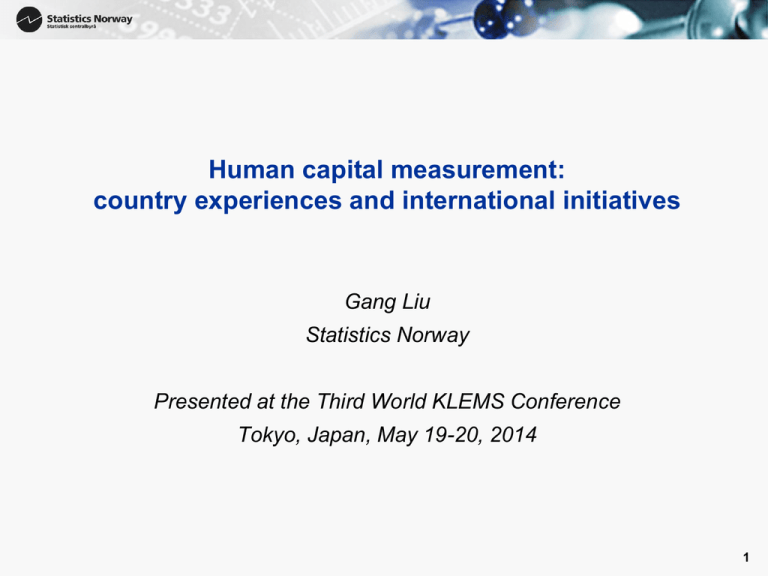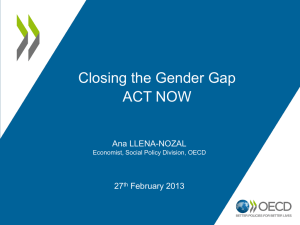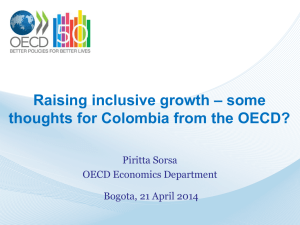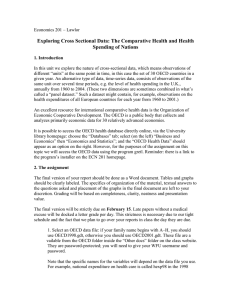Human capital measurement: country experiences and international
advertisement

1 Human capital measurement: country experiences and international initiatives Gang Liu Statistics Norway Presented at the Third World KLEMS Conference Tokyo, Japan, May 19-20, 2014 1 Presentation outline 1. Concept and definition 2. Implications for measurement 3. Country experiences 4. International activities 5. Main issues and challenges 6. Concluding remarks 2 1. Concept and Definition • Roots can be found in the history of economic thought: Petty (1690), Smith (1776), Farr (1853), and Engel (1883). • Recognition regained since 1960s: Schultz (1961), Becker (1964) and Mincer (1974). • The OECD definition: ‘the knowledge, skills, competencies and attributes embodied in individuals that facilitate the creation of personal, social and economic well-being’ (OECD, 2001) • An all-embracing definition that has obtained wide acceptance. 3 1. Concept and Definition (cont.) Box 1. Human capital: a sketch of its formation, composition and benefits generated Human capital investment (both lifelong and life-wide) Human capital embodied in individuals Benefits due to human capital investment Market activities Parenting Economic Education Non-market activities Knowledge Health On-the-job training Informal learning Skills Noneconomic (Personal) Subjective well-being ………… Competencies (Personal) Health care Informed citizens Attributes Migration Noneconomic (Social) ………… (Social) Willingness to cooperate ………… 4 2. Implications for measurement • Stepwise approach: starting from those aspects of either lower conceptual challenges or greater data availability. • Distinguishing health capital from human capital. • Focusing on formal education (as the main form of human capital investment); and on the economic returns to the individual (as the main benefits due to human capital investment), even if the broader OECD definition is accepted as a useful reference point. 5 2. Implications for measurement (Cont.) Box 2. Inputs, outputs and outcomes of education sector Inputs Labor Outputs Intermediate consumptions Number of students/ schooling years by level of education (Visible) (Including both market and nonmarket inputs) with human capital embodied/ accumulated (Invisible) Capital Box 3. Classification of measuring methodologies Outcomes Quantitative indicators Direct outcomes: Test scores (e.g. results of pencil and paper tests) Indicators-based approach Qualitative indicators Both direct and indirect outcomes can be used for quality adjustment for outputs Cost-based approach Human capital measurement Indirect outcomes: Economic benefits Non-economic benefits (Personal) Non-economic benefits (Social) Environmental factors (e.g. innate abilities, cultural, social, and economic backgrounds, as well as political, legal and institutional arrangements) Monetary measures Income-based approach Residual approach 6 3. Country experiences 3.1 Results of the UNECE CES questionnaire on measuring human capital • Purpose • Concept • Methodology • Data sources • Status of the estimates 7 3. Country experiences (Cont.) 3.2 Representative studies using the indicators-based approach • Single indicators : adult literacy rates (e.g. Azariadis and Drazen, 1990; Romer, 1990), school enrolment ratios (e.g. Barro, 1991; Mankiw et al., 1992), average years of schooling (e.g.Temple, 1999; Krueger and Lindahl, 2001). • Dashboard type indicators (e.g. Education at a Glance; Ederer et al., 2007, 2011) • Advantages: simple, less data-demanding • Disadvantages: lack of common metric, not really accounting 8 3. Country experiences (Cont.) 3.3 Representative studies using the cost-based approach • Advantages: data availability, PIM • Disadvantages: cost of production not necessarily equal market value, investment-consumption dichotomy, choice of depreciation • Most well-known studies: Kendrick (1976), Eisner (1985) • Recent national studies: Germany (Ewerhart, 2001, 2003), the Netherlands (Rooijen-Horsten et al., 2007, 2008), Finland (Kokkinen, 2008, 2010) 9 3. Country experiences (Cont.) 3.4 Representative studies using the income-based approach • Advantages: theoretically sound, practically feasible, possible to be incorporated into the SNA in the future • Disadvantages: no perfect labor market, choice of key parameters • Most well-known studies: lifetime income approach by Jorgenson and Fraumeni (1989, 1992a, 1992b) 10 3. Country experiences (Cont.) 3.4 Representative studies using the income-based approach (Cont.) Examples of national studies Jorgenson and Fraumeni (1989, 1992a, 1992b) Ahlroth, et al (1997) Ervik, et al (2003) Wei (2004, 2008) Country Motivation Time range Main data sources Population covered United States New systems of national accounts, Output of education sector Output of education sector Output of higher education sector Incorporating human capital into the SNA (Stock/Flow) 1948-1984, 1947-1987 Rich data based on decades of research Age 0-75 Market/ Nonmarket activities Both 1967, 1973, 1980, 1990 1995 Level of living surveys Register data Age 0-75 Both Age 20-64 Market only 1981-2001 Census data Market only Le, et al (2006) New Zealand India Measuring human capital (Stock) Accounting for human capital formation 1981-2001 Census data Age 18 (25)-65, labor force/whole population Age 18-64 1993-2001 Age 15-60 Market only Gu and Wong (2008) Canada 1970-2007 Age 15-74 Market only Liu and Greaker (2009) Norway Human capital contribution to national wealth account Measuring human capital (Stock) Surveys of employment and unemployment, Census of population Census /labour force survey 2006 Register data Market only Christian (2010) United States 1994-2006 Rich data Coremberg (2010) Argentina 1997, 2001, 2004 Household permanent survey Age 15-65 Market only Li, et al. (2010) China Measuring human capital (Stock/Investment) Measuring human capital (Stock)/Output of education sector Measuring human capital (Stock) Age 15(16)67(74), labor force/ whole population Age 0-80 1985-2007 United Kingdom Measuring human capital (Stock) 2001-2009 Urban/rural, Age 0-60 (55 for female) Age 16-64 Market only Jones and Chiripanhura (2010) Istat (2013) Household survey/Health and nutrition survey Labor force survey Italy Measuring human capital (Stock) 2008 Various surveys Age 15-64 Both Gundimeda, et al (2006) Sweden Norway Australia Market only Both Market only 11 4. International initiatives • Indicators-based approach: Barro and Lee (1993, 1996, 2001, 2010, 2013); OECD (Education at a Glance, PISA, PIAAC); UN (works on constructing sustainable development indices, HDI) • Residual approach: World Bank (2006, 2011) • UN Inclusive Wealth Report (UN-IHDP, UNEP, 2012) • Lifetime income approach: OECD human capital project (Liu, 2011) • Joint work by the World Bank and the OECD (Hamilton and Liu, 2014) 12 4. International initiatives (Cont.) Graph 1: Human capital per capita in 2006 (in thousands US dollars) Human capital per capita (US$ in thousands) GDP per capita (US$ in hundreds) 900 800 700 600 500 400 300 200 100 0 ROU POL ITA ISR NZL ESP NLD DNK AUS FRA KOR JPN CAN NOR GBR USA Note: Estimates for Australia refer to 2001 and for Denmark to 2002. Source: OECD human capital project. 13 4. International initiatives (Cont.) Graph 2. Stock of human capital relative to GDP and to the stock of produced capital, 2006 Panel a. Stock of human capital to GDP Panel b. Stock of human capital to produced capital 8,0 20,0 16,0 6,0 12,0 4,0 8,0 2,0 4,0 0,0 0,0 NLD ITA FRA USA ROU CAN NOR DNK GBR ISR NZL AUS ESP JPN POL KOR ITA NLD FRA DNK USA ESP AUS CAN NZL GBR Note: Estimates for Australia refer to 2001, those for Denmark to 2002. Source: OECD human capital project. 14 4. International initiatives (Cont.) Graph 3. Decomposition of average annual growth of human capital volume per capita due to age, gender and educational attainment (first-order partial volume index, percentages) Age Education Gender HC per capita 2,0 1,5 1,0 0,5 0,0 -0,5 CA N AU S (1 99 7- 20 01 (1 ) 99 720 FR 06 A (1 ) 99 820 IS R 07 (2 ) 00 220 IT 07 A (1 ) 99 820 JP N 06 (2 ) 00 2KO 20 07 R (1 ) 99 8NZ 20 07 L (1 ) 99 7NO 20 07 R (1 ) 99 7PO 20 06 L (1 ) 99 920 ES P 06 (2 ) 00 1GB 20 06 R (1 ) 99 720 US 07 A (1 ) 99 720 07 ) -1,0 Note: For many countries, the contribution from gender is too small to be discernable in the figure. Source: OECD human capital project. 15 4. International initiatives (Cont.) Table 2. Country rankings of human capital measured by different approaches PISA Science 2006 PIIAC Literacy 2011-2 PIAAC Numeracy 2011-2 PIAAC Problemsolving in Tech-rich Environments 2011-2 Barro-Lee Average Educational Attainment 2005 JorgensonFraumeni Human Capital per Capita 1 2006 World Bank Intangible Capital 2005 AGES 15 16-65 16-65 16-65 15-64 15-64 All Ages Australia 3 3 5 4 7 9 6 Canada 4 5 6 5 3 4 7 China 17 18 17 Denmark 10 8 3 3 14 8 2 France 9 11 10 11 7 9 Great Britain 5 7 8 6 16 2 8 India 18 17 18 Israel 8 13 4 Italy 14 13 12 12 14 11 Japan 2 1 1 6 6 6 13 Netherlands 6 2 2 1 9 10 5 New Zealand 1 2 12 3 Norway 12 4 3 2 4 3 1 Poland 11 10 9 10 15 15 14 Romania 10 16 15 South Korea 7 5 7 9 5 5 12 Spain 13 12 13 13 11 10 United States 8 9 11 8 1 1 16 Notes: 1. The J-F figures for Australia and India are for 2001; those for Denmark are for 2002. 2. The ages covered for China include ages 16 through 55 for females and 16 through 59 for males. The ages covered for India include ages 15 through 60. 16 5. Main issues and challenges • Data issues: earnings, enrolments, labor force survey, educational attainment, mortality rates • Methodological difficulties: cohort effects, business cycle effects, choice of key parameters, accounting for divergence between estimates by the cost-based and the income-based approaches 17 6. Concluding remarks • The multifaceted nature requires stepwise approach for human capital measurement, e.g. focusing on formal education and economic returns to individuals as a point of departure. • Monetary measures, such as those by the cost-based and the incomebased approaches, and esp. by the lifetime income approach seem to be most promising to be incorporated into the SNA in the future. • • • • Continue the work on data compilation and harmonization. • Encourage research on streamlined approach for those countries in which the needed data is not available. Modify the methodologies, possibly based on new sources of data. Construct experimental satellite accounts. Link the estimates of human capital to the standard growth accounting framework. 18











